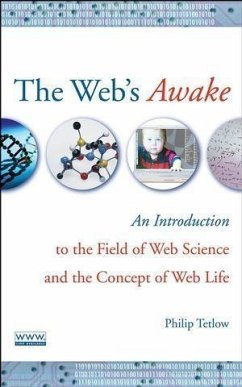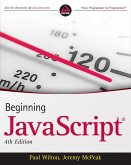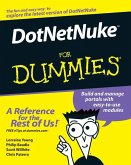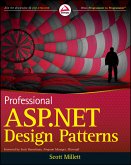Philip D. Tetlow
The Web's Awake (eBook, PDF)
An Introduction to the Field of Web Science and the Concept of Web Life
69,99 €
69,99 €
inkl. MwSt.
Sofort per Download lieferbar

0 °P sammeln
69,99 €
Als Download kaufen

69,99 €
inkl. MwSt.
Sofort per Download lieferbar

0 °P sammeln
Jetzt verschenken
Alle Infos zum eBook verschenken
69,99 €
inkl. MwSt.
Sofort per Download lieferbar
Alle Infos zum eBook verschenken

0 °P sammeln
Philip D. Tetlow
The Web's Awake (eBook, PDF)
An Introduction to the Field of Web Science and the Concept of Web Life
- Format: PDF
- Merkliste
- Auf die Merkliste
- Bewerten Bewerten
- Teilen
- Produkt teilen
- Produkterinnerung
- Produkterinnerung

Bitte loggen Sie sich zunächst in Ihr Kundenkonto ein oder registrieren Sie sich bei
bücher.de, um das eBook-Abo tolino select nutzen zu können.
Hier können Sie sich einloggen
Hier können Sie sich einloggen
Sie sind bereits eingeloggt. Klicken Sie auf 2. tolino select Abo, um fortzufahren.

Bitte loggen Sie sich zunächst in Ihr Kundenkonto ein oder registrieren Sie sich bei bücher.de, um das eBook-Abo tolino select nutzen zu können.
The central thesis of The Web's Awake is that the phenomenal growth and complexity of the web is beginning to outstrip our capability to control it directly. Many have worked on the concept of emergent properties within highly complex systems, concentrating heavily on the underlying mechanics concerned. Few, however, have studied the fundamentals involved from a sociotechnical perspective. In short, the virtual anatomy of the Web remains relatively uninvestigated. The Web's Awake attempts to seriously explore this gap, citing a number of provocative, yet objective, similarities from studies…mehr
- Geräte: PC
- mit Kopierschutz
- eBook Hilfe
- Größe: 2.61MB
Andere Kunden interessierten sich auch für
![Beginning JavaScript (eBook, PDF) Beginning JavaScript (eBook, PDF)]() Paul WiltonBeginning JavaScript (eBook, PDF)24,99 €
Paul WiltonBeginning JavaScript (eBook, PDF)24,99 €![Microsoft Expression Web For Dummies (eBook, PDF) Microsoft Expression Web For Dummies (eBook, PDF)]() Linda HeffermanMicrosoft Expression Web For Dummies (eBook, PDF)22,99 €
Linda HeffermanMicrosoft Expression Web For Dummies (eBook, PDF)22,99 €![DotNetNuke For Dummies (eBook, PDF) DotNetNuke For Dummies (eBook, PDF)]() Lorraine YoungDotNetNuke For Dummies (eBook, PDF)17,99 €
Lorraine YoungDotNetNuke For Dummies (eBook, PDF)17,99 €![TypePad For Dummies (eBook, PDF) TypePad For Dummies (eBook, PDF)]() Melanie NelsonTypePad For Dummies (eBook, PDF)17,99 €
Melanie NelsonTypePad For Dummies (eBook, PDF)17,99 €![Professional ASP.NET Design Patterns (eBook, PDF) Professional ASP.NET Design Patterns (eBook, PDF)]() Scott MillettProfessional ASP.NET Design Patterns (eBook, PDF)32,99 €
Scott MillettProfessional ASP.NET Design Patterns (eBook, PDF)32,99 €![Building Web Sites All-in-One Desk Reference For Dummies (eBook, PDF) Building Web Sites All-in-One Desk Reference For Dummies (eBook, PDF)]() Doug SahlinBuilding Web Sites All-in-One Desk Reference For Dummies (eBook, PDF)21,99 €
Doug SahlinBuilding Web Sites All-in-One Desk Reference For Dummies (eBook, PDF)21,99 €![HTML5, JavaScript, and jQuery 24-Hour Trainer (eBook, PDF) HTML5, JavaScript, and jQuery 24-Hour Trainer (eBook, PDF)]() Dane CameronHTML5, JavaScript, and jQuery 24-Hour Trainer (eBook, PDF)28,99 €
Dane CameronHTML5, JavaScript, and jQuery 24-Hour Trainer (eBook, PDF)28,99 €-
-
-
The central thesis of The Web's Awake is that the phenomenal growth and complexity of the web is beginning to outstrip our capability to control it directly. Many have worked on the concept of emergent properties within highly complex systems, concentrating heavily on the underlying mechanics concerned. Few, however, have studied the fundamentals involved from a sociotechnical perspective. In short, the virtual anatomy of the Web remains relatively uninvestigated. The Web's Awake attempts to seriously explore this gap, citing a number of provocative, yet objective, similarities from studies relating to both real world and digital systems. It presents a collage of interlinked facts, assertions, and coincidences, which boldly point to a Web with powerful potential for life.
Dieser Download kann aus rechtlichen Gründen nur mit Rechnungsadresse in D ausgeliefert werden.
Produktdetails
- Produktdetails
- Verlag: John Wiley & Sons
- Erscheinungstermin: 30. August 2007
- Englisch
- ISBN-13: 9780470145869
- Artikelnr.: 37290950
- Verlag: John Wiley & Sons
- Erscheinungstermin: 30. August 2007
- Englisch
- ISBN-13: 9780470145869
- Artikelnr.: 37290950
- Herstellerkennzeichnung Die Herstellerinformationen sind derzeit nicht verfügbar.
Philip Tetlow is a Senior Certified IT Architect in IBM's Global Business Services Division, a Chartered Engineer, and an Open Group Master IT Architect. He has more than twenty years of experience in the IT industry, specializing in the application of Web-based technologies, metadata, and transformation techniques on large central government systems. He is a member of the World Wide Web Consortium and was responsible for coordinating its task force on the application of the semantic Web in software engineering.
Foreword.
Preface.
Acknowledgments.
Prologue.
CHAPTER 1 THE WEB AND LIFE.
Introduction.
Almost None of This Is New.
Where to Begin?-Web Misconceptions and Folklore.
Our Understandings of the Web.
Power of the People.
The Dark Side of the Force.
What Would a Web Be Without the Holes?
Structure Abounds.
Four Dimensions Are Not Enough.
Our Understandings of Life.
Life's Playground-A Universe of Infinite Possibilities.
Enquiries into the Definition of Life.
More Contemporary Viewpoints on Life.
CHAPTER 2 THE SPECTRUM OF COMPLEXITY.
A Complex Web.
The Natural Mix of Order and Disorder.
Emergence-The Complexity Sweet Spot.
Mankind, Complexity, and Our Attempts to Understand the Unreal.
Could You Repeat That Please?
Self-Similarity and Recursion.
Back to Measures of Complexity.
The Theory of Complexity.
The Crossover Between Orderly and Chaotic Systems.
Onwards to Chaos.
Modern-Day Approaches to Complexity.
CHAPTER 3 THE IMPORTANCE OF DISCRETENESS AND SYMMETRY IN SYSTEMS.
Let's Be Discrete.
A Brief Word of Warning.
Boiling the Numbers Out of Computing.
The Power of Two.
Let's Split the Difference.
Symmetry in Systems.
CHAPTER 4 NATURAL STRUCTURES FOR MAN-MADE MACHINES- CURVATURE IN
INFORMATION AND COMPUTATION.
Engineering Problems.
Arrows Everywhere-Graph Theory and Feynman-Like Diagrams.
Relays and Switches by Any Other Name.
Differentiation Through Divergence.
Relationships and Twisting Sequences.
Growth Spirals, Fibonacci Progressions, and Other Sequential Patterns.
L-Systems.
Information Compression and Maximization in Biological Systems.
Degrees of Freedom and Information Representation in Biological Systems.
A More Detailed Account of DNA's Structure.
More Evidence of Efficiency at Play in DNA and Higher Levels of Physiology.
Books, Bytes, Computers, and Biological Systems-An Analogy.
CHAPTER 5 POSITIONAL INFORMATION AND SCALE-FREE NETWORKS.
A Right Place for Everything.
What Is Information Anyway?
A Bow to Tie Coincidence Together.
Why Is Kevin Bacon so Important?
Scale-Free Networks.
The Web's Body Mass.
DNA as an Ontogenetic Database.
Back to Gödel-Compression, Keys, Catalysts, and Restrictors.
CHAPTER 6 EVOLUTION THROUGH ENGINEERING.
Some Key Questions Still Remain.
Memes and Universal Darwinism.
Boolean Logic, Regulatory Networks, and New Forms of Life.
Binary Biological Machines.
nK Networks.
"X" as a Canonical Super Pattern.
Autocatalytic Sets.
CHAPTER 7 A LESS-THAN-SIMPLE MATTER OF BOUNDLESS ORGANICS.
Open Worlds, Feedback, and Critical Self-Organization.
Gödel, Incompleteness, and Maintenance Through Changing Boundaries.
An Abstractionless Universe.
Self-Sustaining, Self-Organizing Systems.
CHAPTER 8 EMERGENT INTELLIGENCE AND POSTHUMAN CONCEPTS.
Why on the Web?
Technology Lock-In.
Swarm Behavior.
Artificial Life.
The Swarm Being that Is the Web.
The Web's Core Memory and Its Place in Information Value.
The Apparent Failure of Artificial Intelligence.
Posthuman Philosophies and Collective Consciousness.
The Penrose Paradox.
CHAPTER 9 THE PHYSICS OF INFORMATION AND COMPUTING.
The Attraction of "Why" and the Ubiquity of Complexity as a Metaproperty.
Spin Glass.
Quantum Comparisons.
More about Dimensions.
Strange Loops, Spin Networks, and Problems with the Web's Constitution.
Computational Duality.
The Web's Superposition.
Could Penrose Be Right After All?
Quantum Brains.
One Big Spiny String Thing.
Quantum Darwinism.
CHAPTER 10 COUNTER ARGUMENTS.
All Those Against.
Computing the Incomputable.
Observation and Practicality in Computation.
Spaceships Can Come in Handy.
When Is a Curve not a Curve, When Is a Brain not a Brain?
A Matter of What, not How.
CHAPTER 11 OBJECTIVE OPINIONS.
Opinions of the Uber-Geeks.
Are We Right to Talk about a Global "Brain"?
Over the Horizon.
A Final Sprinkle of Philosophy.
APPENDIX A AN OUTLINE OF THE SEMANTIC WEB AND ITS POTENTIAL FOR SOFTWARE
ENGINEERING.
Blue Chips.
Semantic Web Technologies Make the Web's Meaning Much More Specific.
Autonomic Systems and Software Engineering.
The Future of Software Engineering Lies with Discovery.
Smushing.
Runtime Autonomic Semantic Applications.
StumbleUpon.
APPENDIX B BEYOND THE SEMANTIC WEB.
Overlaps.
A Semantic Web Primer for Object-Oriented Software Practitioners.
References.
Index.
About the Author.
Preface.
Acknowledgments.
Prologue.
CHAPTER 1 THE WEB AND LIFE.
Introduction.
Almost None of This Is New.
Where to Begin?-Web Misconceptions and Folklore.
Our Understandings of the Web.
Power of the People.
The Dark Side of the Force.
What Would a Web Be Without the Holes?
Structure Abounds.
Four Dimensions Are Not Enough.
Our Understandings of Life.
Life's Playground-A Universe of Infinite Possibilities.
Enquiries into the Definition of Life.
More Contemporary Viewpoints on Life.
CHAPTER 2 THE SPECTRUM OF COMPLEXITY.
A Complex Web.
The Natural Mix of Order and Disorder.
Emergence-The Complexity Sweet Spot.
Mankind, Complexity, and Our Attempts to Understand the Unreal.
Could You Repeat That Please?
Self-Similarity and Recursion.
Back to Measures of Complexity.
The Theory of Complexity.
The Crossover Between Orderly and Chaotic Systems.
Onwards to Chaos.
Modern-Day Approaches to Complexity.
CHAPTER 3 THE IMPORTANCE OF DISCRETENESS AND SYMMETRY IN SYSTEMS.
Let's Be Discrete.
A Brief Word of Warning.
Boiling the Numbers Out of Computing.
The Power of Two.
Let's Split the Difference.
Symmetry in Systems.
CHAPTER 4 NATURAL STRUCTURES FOR MAN-MADE MACHINES- CURVATURE IN
INFORMATION AND COMPUTATION.
Engineering Problems.
Arrows Everywhere-Graph Theory and Feynman-Like Diagrams.
Relays and Switches by Any Other Name.
Differentiation Through Divergence.
Relationships and Twisting Sequences.
Growth Spirals, Fibonacci Progressions, and Other Sequential Patterns.
L-Systems.
Information Compression and Maximization in Biological Systems.
Degrees of Freedom and Information Representation in Biological Systems.
A More Detailed Account of DNA's Structure.
More Evidence of Efficiency at Play in DNA and Higher Levels of Physiology.
Books, Bytes, Computers, and Biological Systems-An Analogy.
CHAPTER 5 POSITIONAL INFORMATION AND SCALE-FREE NETWORKS.
A Right Place for Everything.
What Is Information Anyway?
A Bow to Tie Coincidence Together.
Why Is Kevin Bacon so Important?
Scale-Free Networks.
The Web's Body Mass.
DNA as an Ontogenetic Database.
Back to Gödel-Compression, Keys, Catalysts, and Restrictors.
CHAPTER 6 EVOLUTION THROUGH ENGINEERING.
Some Key Questions Still Remain.
Memes and Universal Darwinism.
Boolean Logic, Regulatory Networks, and New Forms of Life.
Binary Biological Machines.
nK Networks.
"X" as a Canonical Super Pattern.
Autocatalytic Sets.
CHAPTER 7 A LESS-THAN-SIMPLE MATTER OF BOUNDLESS ORGANICS.
Open Worlds, Feedback, and Critical Self-Organization.
Gödel, Incompleteness, and Maintenance Through Changing Boundaries.
An Abstractionless Universe.
Self-Sustaining, Self-Organizing Systems.
CHAPTER 8 EMERGENT INTELLIGENCE AND POSTHUMAN CONCEPTS.
Why on the Web?
Technology Lock-In.
Swarm Behavior.
Artificial Life.
The Swarm Being that Is the Web.
The Web's Core Memory and Its Place in Information Value.
The Apparent Failure of Artificial Intelligence.
Posthuman Philosophies and Collective Consciousness.
The Penrose Paradox.
CHAPTER 9 THE PHYSICS OF INFORMATION AND COMPUTING.
The Attraction of "Why" and the Ubiquity of Complexity as a Metaproperty.
Spin Glass.
Quantum Comparisons.
More about Dimensions.
Strange Loops, Spin Networks, and Problems with the Web's Constitution.
Computational Duality.
The Web's Superposition.
Could Penrose Be Right After All?
Quantum Brains.
One Big Spiny String Thing.
Quantum Darwinism.
CHAPTER 10 COUNTER ARGUMENTS.
All Those Against.
Computing the Incomputable.
Observation and Practicality in Computation.
Spaceships Can Come in Handy.
When Is a Curve not a Curve, When Is a Brain not a Brain?
A Matter of What, not How.
CHAPTER 11 OBJECTIVE OPINIONS.
Opinions of the Uber-Geeks.
Are We Right to Talk about a Global "Brain"?
Over the Horizon.
A Final Sprinkle of Philosophy.
APPENDIX A AN OUTLINE OF THE SEMANTIC WEB AND ITS POTENTIAL FOR SOFTWARE
ENGINEERING.
Blue Chips.
Semantic Web Technologies Make the Web's Meaning Much More Specific.
Autonomic Systems and Software Engineering.
The Future of Software Engineering Lies with Discovery.
Smushing.
Runtime Autonomic Semantic Applications.
StumbleUpon.
APPENDIX B BEYOND THE SEMANTIC WEB.
Overlaps.
A Semantic Web Primer for Object-Oriented Software Practitioners.
References.
Index.
About the Author.
Foreword.
Preface.
Acknowledgments.
Prologue.
CHAPTER 1 THE WEB AND LIFE.
Introduction.
Almost None of This Is New.
Where to Begin?-Web Misconceptions and Folklore.
Our Understandings of the Web.
Power of the People.
The Dark Side of the Force.
What Would a Web Be Without the Holes?
Structure Abounds.
Four Dimensions Are Not Enough.
Our Understandings of Life.
Life's Playground-A Universe of Infinite Possibilities.
Enquiries into the Definition of Life.
More Contemporary Viewpoints on Life.
CHAPTER 2 THE SPECTRUM OF COMPLEXITY.
A Complex Web.
The Natural Mix of Order and Disorder.
Emergence-The Complexity Sweet Spot.
Mankind, Complexity, and Our Attempts to Understand the Unreal.
Could You Repeat That Please?
Self-Similarity and Recursion.
Back to Measures of Complexity.
The Theory of Complexity.
The Crossover Between Orderly and Chaotic Systems.
Onwards to Chaos.
Modern-Day Approaches to Complexity.
CHAPTER 3 THE IMPORTANCE OF DISCRETENESS AND SYMMETRY IN SYSTEMS.
Let's Be Discrete.
A Brief Word of Warning.
Boiling the Numbers Out of Computing.
The Power of Two.
Let's Split the Difference.
Symmetry in Systems.
CHAPTER 4 NATURAL STRUCTURES FOR MAN-MADE MACHINES- CURVATURE IN
INFORMATION AND COMPUTATION.
Engineering Problems.
Arrows Everywhere-Graph Theory and Feynman-Like Diagrams.
Relays and Switches by Any Other Name.
Differentiation Through Divergence.
Relationships and Twisting Sequences.
Growth Spirals, Fibonacci Progressions, and Other Sequential Patterns.
L-Systems.
Information Compression and Maximization in Biological Systems.
Degrees of Freedom and Information Representation in Biological Systems.
A More Detailed Account of DNA's Structure.
More Evidence of Efficiency at Play in DNA and Higher Levels of Physiology.
Books, Bytes, Computers, and Biological Systems-An Analogy.
CHAPTER 5 POSITIONAL INFORMATION AND SCALE-FREE NETWORKS.
A Right Place for Everything.
What Is Information Anyway?
A Bow to Tie Coincidence Together.
Why Is Kevin Bacon so Important?
Scale-Free Networks.
The Web's Body Mass.
DNA as an Ontogenetic Database.
Back to Gödel-Compression, Keys, Catalysts, and Restrictors.
CHAPTER 6 EVOLUTION THROUGH ENGINEERING.
Some Key Questions Still Remain.
Memes and Universal Darwinism.
Boolean Logic, Regulatory Networks, and New Forms of Life.
Binary Biological Machines.
nK Networks.
"X" as a Canonical Super Pattern.
Autocatalytic Sets.
CHAPTER 7 A LESS-THAN-SIMPLE MATTER OF BOUNDLESS ORGANICS.
Open Worlds, Feedback, and Critical Self-Organization.
Gödel, Incompleteness, and Maintenance Through Changing Boundaries.
An Abstractionless Universe.
Self-Sustaining, Self-Organizing Systems.
CHAPTER 8 EMERGENT INTELLIGENCE AND POSTHUMAN CONCEPTS.
Why on the Web?
Technology Lock-In.
Swarm Behavior.
Artificial Life.
The Swarm Being that Is the Web.
The Web's Core Memory and Its Place in Information Value.
The Apparent Failure of Artificial Intelligence.
Posthuman Philosophies and Collective Consciousness.
The Penrose Paradox.
CHAPTER 9 THE PHYSICS OF INFORMATION AND COMPUTING.
The Attraction of "Why" and the Ubiquity of Complexity as a Metaproperty.
Spin Glass.
Quantum Comparisons.
More about Dimensions.
Strange Loops, Spin Networks, and Problems with the Web's Constitution.
Computational Duality.
The Web's Superposition.
Could Penrose Be Right After All?
Quantum Brains.
One Big Spiny String Thing.
Quantum Darwinism.
CHAPTER 10 COUNTER ARGUMENTS.
All Those Against.
Computing the Incomputable.
Observation and Practicality in Computation.
Spaceships Can Come in Handy.
When Is a Curve not a Curve, When Is a Brain not a Brain?
A Matter of What, not How.
CHAPTER 11 OBJECTIVE OPINIONS.
Opinions of the Uber-Geeks.
Are We Right to Talk about a Global "Brain"?
Over the Horizon.
A Final Sprinkle of Philosophy.
APPENDIX A AN OUTLINE OF THE SEMANTIC WEB AND ITS POTENTIAL FOR SOFTWARE
ENGINEERING.
Blue Chips.
Semantic Web Technologies Make the Web's Meaning Much More Specific.
Autonomic Systems and Software Engineering.
The Future of Software Engineering Lies with Discovery.
Smushing.
Runtime Autonomic Semantic Applications.
StumbleUpon.
APPENDIX B BEYOND THE SEMANTIC WEB.
Overlaps.
A Semantic Web Primer for Object-Oriented Software Practitioners.
References.
Index.
About the Author.
Preface.
Acknowledgments.
Prologue.
CHAPTER 1 THE WEB AND LIFE.
Introduction.
Almost None of This Is New.
Where to Begin?-Web Misconceptions and Folklore.
Our Understandings of the Web.
Power of the People.
The Dark Side of the Force.
What Would a Web Be Without the Holes?
Structure Abounds.
Four Dimensions Are Not Enough.
Our Understandings of Life.
Life's Playground-A Universe of Infinite Possibilities.
Enquiries into the Definition of Life.
More Contemporary Viewpoints on Life.
CHAPTER 2 THE SPECTRUM OF COMPLEXITY.
A Complex Web.
The Natural Mix of Order and Disorder.
Emergence-The Complexity Sweet Spot.
Mankind, Complexity, and Our Attempts to Understand the Unreal.
Could You Repeat That Please?
Self-Similarity and Recursion.
Back to Measures of Complexity.
The Theory of Complexity.
The Crossover Between Orderly and Chaotic Systems.
Onwards to Chaos.
Modern-Day Approaches to Complexity.
CHAPTER 3 THE IMPORTANCE OF DISCRETENESS AND SYMMETRY IN SYSTEMS.
Let's Be Discrete.
A Brief Word of Warning.
Boiling the Numbers Out of Computing.
The Power of Two.
Let's Split the Difference.
Symmetry in Systems.
CHAPTER 4 NATURAL STRUCTURES FOR MAN-MADE MACHINES- CURVATURE IN
INFORMATION AND COMPUTATION.
Engineering Problems.
Arrows Everywhere-Graph Theory and Feynman-Like Diagrams.
Relays and Switches by Any Other Name.
Differentiation Through Divergence.
Relationships and Twisting Sequences.
Growth Spirals, Fibonacci Progressions, and Other Sequential Patterns.
L-Systems.
Information Compression and Maximization in Biological Systems.
Degrees of Freedom and Information Representation in Biological Systems.
A More Detailed Account of DNA's Structure.
More Evidence of Efficiency at Play in DNA and Higher Levels of Physiology.
Books, Bytes, Computers, and Biological Systems-An Analogy.
CHAPTER 5 POSITIONAL INFORMATION AND SCALE-FREE NETWORKS.
A Right Place for Everything.
What Is Information Anyway?
A Bow to Tie Coincidence Together.
Why Is Kevin Bacon so Important?
Scale-Free Networks.
The Web's Body Mass.
DNA as an Ontogenetic Database.
Back to Gödel-Compression, Keys, Catalysts, and Restrictors.
CHAPTER 6 EVOLUTION THROUGH ENGINEERING.
Some Key Questions Still Remain.
Memes and Universal Darwinism.
Boolean Logic, Regulatory Networks, and New Forms of Life.
Binary Biological Machines.
nK Networks.
"X" as a Canonical Super Pattern.
Autocatalytic Sets.
CHAPTER 7 A LESS-THAN-SIMPLE MATTER OF BOUNDLESS ORGANICS.
Open Worlds, Feedback, and Critical Self-Organization.
Gödel, Incompleteness, and Maintenance Through Changing Boundaries.
An Abstractionless Universe.
Self-Sustaining, Self-Organizing Systems.
CHAPTER 8 EMERGENT INTELLIGENCE AND POSTHUMAN CONCEPTS.
Why on the Web?
Technology Lock-In.
Swarm Behavior.
Artificial Life.
The Swarm Being that Is the Web.
The Web's Core Memory and Its Place in Information Value.
The Apparent Failure of Artificial Intelligence.
Posthuman Philosophies and Collective Consciousness.
The Penrose Paradox.
CHAPTER 9 THE PHYSICS OF INFORMATION AND COMPUTING.
The Attraction of "Why" and the Ubiquity of Complexity as a Metaproperty.
Spin Glass.
Quantum Comparisons.
More about Dimensions.
Strange Loops, Spin Networks, and Problems with the Web's Constitution.
Computational Duality.
The Web's Superposition.
Could Penrose Be Right After All?
Quantum Brains.
One Big Spiny String Thing.
Quantum Darwinism.
CHAPTER 10 COUNTER ARGUMENTS.
All Those Against.
Computing the Incomputable.
Observation and Practicality in Computation.
Spaceships Can Come in Handy.
When Is a Curve not a Curve, When Is a Brain not a Brain?
A Matter of What, not How.
CHAPTER 11 OBJECTIVE OPINIONS.
Opinions of the Uber-Geeks.
Are We Right to Talk about a Global "Brain"?
Over the Horizon.
A Final Sprinkle of Philosophy.
APPENDIX A AN OUTLINE OF THE SEMANTIC WEB AND ITS POTENTIAL FOR SOFTWARE
ENGINEERING.
Blue Chips.
Semantic Web Technologies Make the Web's Meaning Much More Specific.
Autonomic Systems and Software Engineering.
The Future of Software Engineering Lies with Discovery.
Smushing.
Runtime Autonomic Semantic Applications.
StumbleUpon.
APPENDIX B BEYOND THE SEMANTIC WEB.
Overlaps.
A Semantic Web Primer for Object-Oriented Software Practitioners.
References.
Index.
About the Author.
"I recommend this book to anyone who has an interest in how the World Wide Web has developed, and continues to evolve." (British Computer Society Book Reviews)
"...a surprisingly easy and engaging book to read...an essential book for anyone interested in artificial life, artificial intelligence and information studies." (CHOICE, October 2007)
"...a compelling and enjoyable read, enthralling and thought-provoking...a fascinating and provocative perspective on what the Web is and what it will be." (SirReadaLot.org, June 2007)
"...a surprisingly easy and engaging book to read...an essential book for anyone interested in artificial life, artificial intelligence and information studies." (CHOICE, October 2007)
"...a compelling and enjoyable read, enthralling and thought-provoking...a fascinating and provocative perspective on what the Web is and what it will be." (SirReadaLot.org, June 2007)







